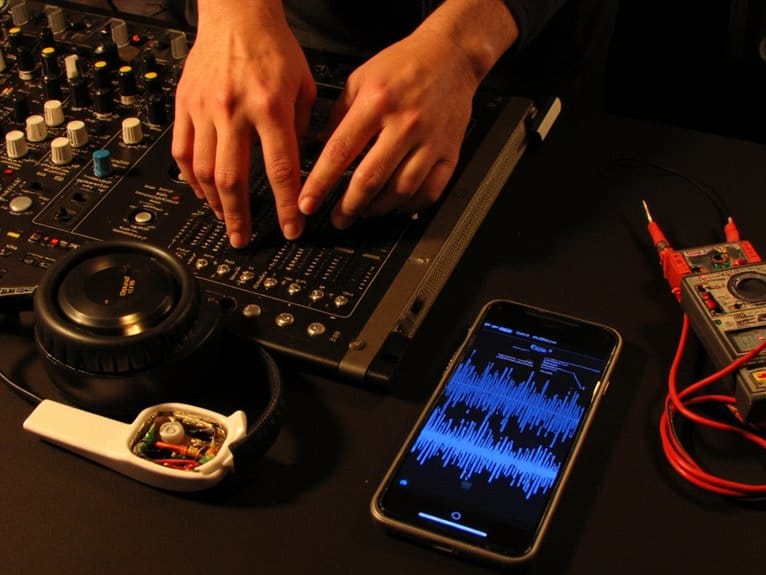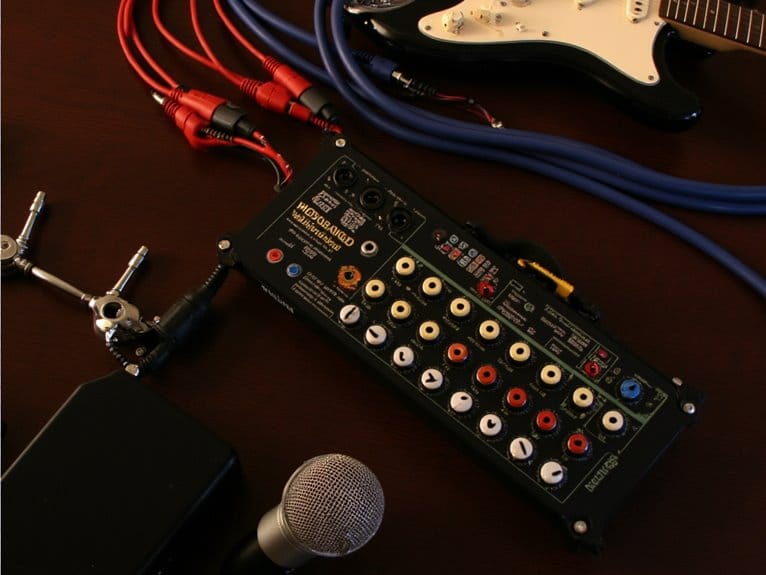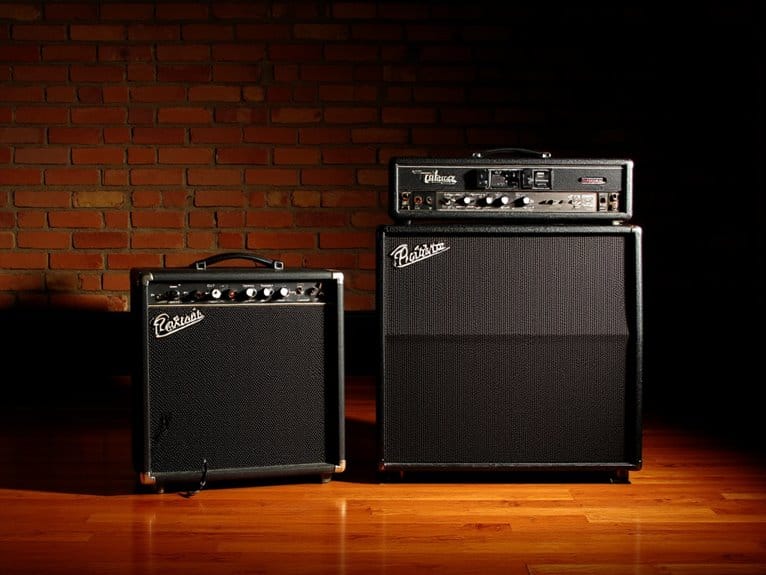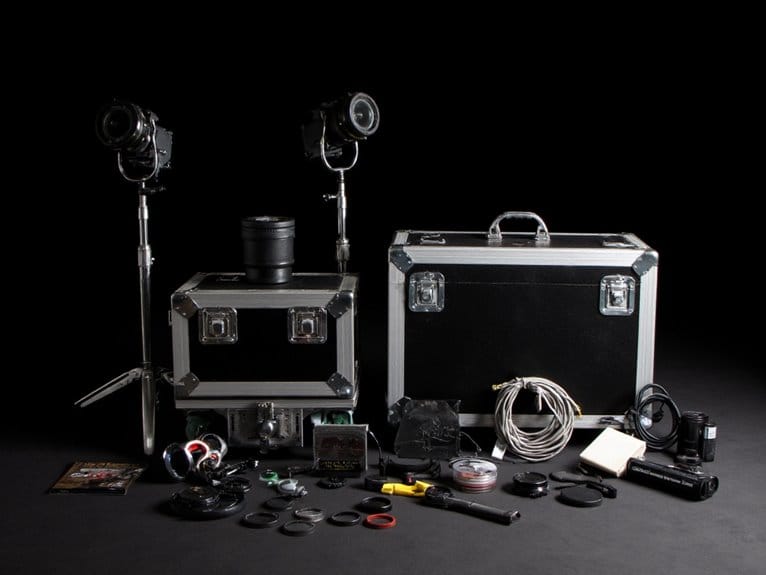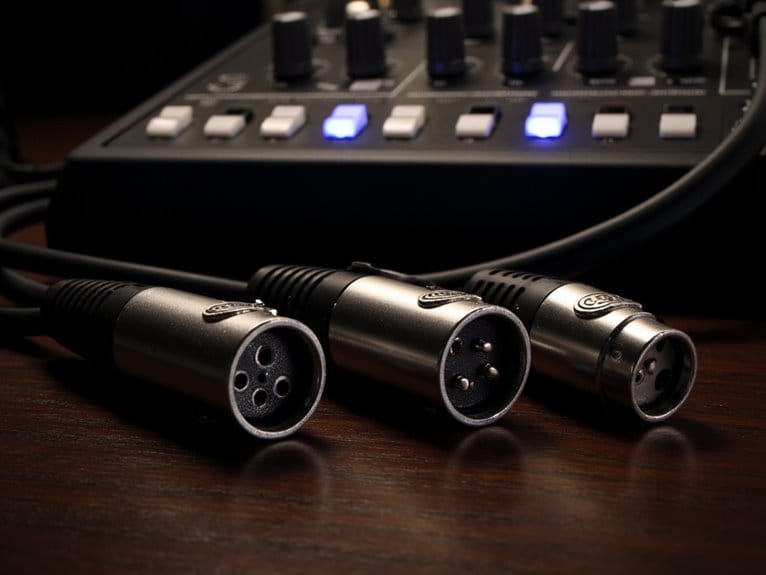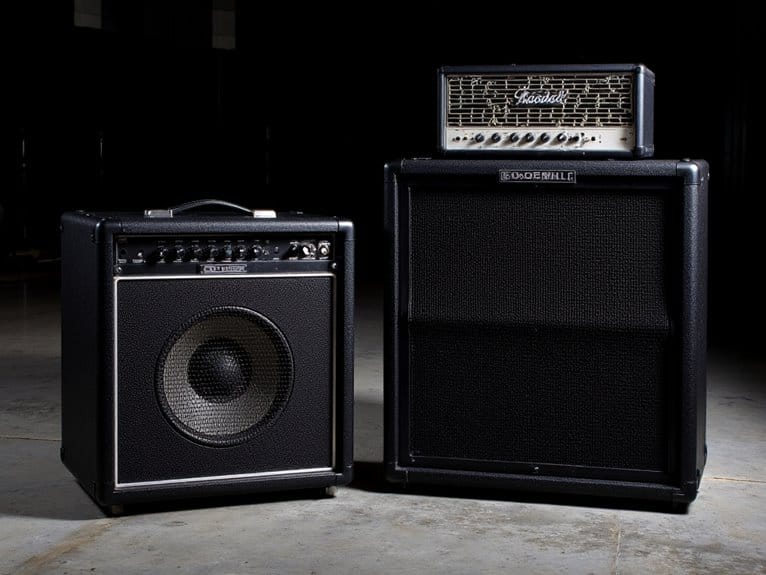Audio Troubleshooting: Common Problems and Solutions
When you’re dealing with audio problems, start by checking volume levels to prevent digital clipping, then inspect cables for fraying or poor connections that cause crackling sounds. If you’re hearing constant humming, it’s likely a ground loop from different power outlets or electromagnetic interference from nearby appliances. For complete audio loss, verify power connections and confirm correct output devices are selected in your system settings. This systematic approach will help you identify whether the issue stems from hardware failures, driver conflicts, or interference sources, and the following troubleshooting steps will guide you through more advanced diagnostic techniques.
We are supported by our audience. When you purchase through links on our site, we may earn an affiliate commission, at no extra cost for you. Learn more.
Notable Insights
- Check volume levels and inspect cables for distortion and crackling sounds caused by overloaded inputs or faulty wiring.
- Identify ground loops and electromagnetic interference from appliances to resolve constant humming and buzzing issues in audio systems.
- Verify power connections, cable integrity, and audio settings to troubleshoot complete audio loss or single channel problems.
- Access system sound settings and update audio drivers to resolve software-related configuration issues and compatibility problems.
- Seek professional repair services for complex circuit board damage, safety hazards, or high-voltage circuit issues.
Identifying and Fixing Distortion and Crackling Sounds
When you’re dealing with distorted or crackling audio, I’ve found that the frustration often stems from not knowing whether the problem lies in your equipment, connections, or settings—but the good news is that most of these issues follow predictable patterns that you can systematically troubleshoot.
Start by identifying causes through methodical testing: check your volume levels first, since digital clipping from overloaded inputs creates that harsh, crackling sound you’re recognizing symptoms of right away.
Next, inspect your cables and connections, as faulty wiring generates persistent crackling that’s unmistakable.
If you’re still hearing distortion, test each component individually—from microphone to amplifier to speakers—isolating where the problem originates, then address it with appropriate level adjustments or equipment replacement.
Additionally, consider electromagnetic interference from nearby electronic devices, which can introduce unwanted noise and crackling into your audio signal that’s often overlooked during troubleshooting.
Resolving Constant Humming and Buzzing Issues
When you’re dealing with that persistent hum or buzz coming through your speakers, I’ve found that systematically identifying the interference sources will save you hours of frustration and random cable swapping.
The culprit usually stems from ground loops between different power outlets, electromagnetic interference from nearby appliances like refrigerators or dimmer switches, or poor cable positioning that allows AC lines to induce noise into your audio signals. Poor gain staging can also introduce unwanted signal interference, compounding these existing noise issues in your system.
Your success in eliminating these issues depends largely on understanding proper grounding techniques, strategic equipment positioning away from interference sources, and recognizing how different connection types affect your system’s susceptibility to electrical noise.
Additionally, enabling high-pass filters on your audio interface can effectively reduce low-frequency rumble and handling noise that often contributes to unwanted background interference in your recordings.
Identifying Interference Sources
Tracking down the source of persistent humming and buzzing in your audio system can feel like detective work, but I’ve found that most interference issues stem from a handful of predictable culprits that you can systematically eliminate. The key to effective interference detection lies in methodical isolation, which prevents further signal degradation while you troubleshoot.
| Interference Source | Identification Method |
|---|---|
| Wireless devices | Move phones, routers away from speakers |
| Power transformers | Listen for 60Hz hum near amplifier chassis |
| Poor cables | Wiggle connections, check for intermittent noise |
| EMI from electronics | Turn off fluorescent lights, dimmers systematically |
| Computer noise | Disconnect USB cables, use external audio interface |
Start by powering down potential sources one by one—you’ll quickly isolate the offending device. Once you’ve identified the interference source, ensure your gain staging is properly configured throughout the signal chain, as poor level management can amplify existing noise issues and create additional unwanted artifacts.
For persistent noise issues over longer cable runs, consider switching to balanced connections which use common-mode rejection to actively cancel electromagnetic interference that commonly affects unbalanced setups.
Grounding and Positioning
Once you’ve pinpointed the interference source, the real work begins with addressing the underlying grounding and positioning issues that allow these problems to persist in your audio system.
Ground loop identification starts with recognizing that telltale 60Hz hum, which typically occurs when your amplifier and other components draw power from different outlets, creating electrical potential differences that manifest as annoying buzzing sounds.
I’ve found that speaker placement plays an equally essential role, since positioning speakers too close to electronic devices, routers, or other magnetic field sources can introduce electromagnetic interference that compromises your audio quality.
Moving speakers away from these potential interference sources, while ensuring all components share common grounding through proper power distribution, effectively eliminates most persistent humming issues.
In recording setups, proper gain staging to around -20 dBFS helps prevent amplification of background noise and interference that can compound these grounding problems.
Troubleshooting Complete Audio Loss
When you’re facing complete audio loss, I’ve found that systematically checking your power connections and cable integrity often reveals the most obvious culprits, since loose headphone jacks, unpowered speakers, or disconnected USB audio devices account for roughly 40% of silent system scenarios.
You’ll want to verify that your system’s audio settings haven’t defaulted to an incorrect output device, particularly after Windows updates or driver installations, which frequently reset your preferred audio hardware to generic Microsoft drivers.
Testing each hardware component individually, from different headphones to alternate audio ports, helps isolate whether you’re dealing with a software configuration issue, a failed audio driver, or actual hardware failure. Remember that signal attenuation becomes noticeable around the 20-foot mark with longer cable runs, which can contribute to perceived audio loss even when connections appear secure.
Additionally, check that your XLR connections are properly seated and balanced, as these professional audio interfaces rely on secure impedance-matched connections to eliminate interference and maintain signal integrity throughout your audio chain.
Check Power and Connections
Since complete audio loss can stem from the most basic power and connection issues, I’ve learned through countless troubleshooting sessions that methodically verifying these fundamentals first saves hours of unnecessary diagnostic work down the line.
Start by powering off your system completely, then check your power outlet using a digital multimeter to confirm proper voltage delivery. I can’t count how many times a tripped breaker masqueraded as equipment failure.
Next, systematically inspect cable integrity throughout your signal chain:
- Examine all cables for visible damage like frayed wires or loose connectors
- Verify secure connections between audio sources, amplifiers, and speakers
- Test suspected faulty cables by swapping with known working ones
Finally, confirm proper speaker wire polarity and verify each device’s power indicators are active before proceeding to more complex diagnostics. For microphone-specific issues, examine connector pins on 3.5mm, XLR, or USB plugs for straightness and cleanliness, as damaged pins frequently cause complete audio failure.
Verify System Audio Settings
Before diving into hardware diagnostics or driver reinstallation, I’ve discovered that Windows’ own audio settings frequently harbor the culprits behind sudden sound disappearances, making system-level verification a crucial second step after confirming physical connections.
Start by accessing Settings > System > Sound, where you’ll find your primary audio interface configuration. Then examine each device’s individual properties to verify proper volume levels and enabled status. I’ve found that muted system sounds, incorrect default playback devices, or accidentally disabled audio interfaces cause most mysterious sound losses.
Navigate to the Enhancements tab within your device properties and disable all sound effects, as these sound optimization features often conflict with drivers. Poor driver quality can lead to audio dropouts and other performance issues that may manifest as complete sound loss.
Finally, check Device Manager’s audio section for any warning indicators or outdated drivers requiring immediate attention.
If you’re using professional recording equipment, ensure your audio interface drivers are properly installed and configured, as these devices require specific ASIO drivers on Windows for optimal performance.
Test Hardware Components
After exhausting software-level solutions, I’ve learned that methodical hardware testing often reveals the actual source of audio problems, particularly when system settings appear correct but sound remains absent.
Begin speaker testing by examining physical connections, ensuring cables are securely plugged into correct green output jacks, then verify power switches and input selections.
If you’re troubleshooting headphone functionality, check volume controls aren’t muted and inspect cables for damage before trying alternative headphones.
Essential hardware verification steps include:
- Port inspection – Clean debris from audio jacks and test different output ports
- Cable swapping – Replace potentially faulty cables to isolate connection issues
- Device isolation – Test multiple audio devices to pinpoint whether speakers, headphones, or computer ports are malfunctioning
When testing microphones specifically, dynamic microphones are generally more robust and better at handling high SPLs without distortion, making them less likely to fail during troubleshooting compared to more sensitive condenser types. Make sure to verify that condenser microphones are receiving proper phantom power if they appear completely unresponsive during testing.
This systematic approach eliminates guesswork while identifying specific hardware failures.
Diagnosing Power-Related Audio Problems
When your audio equipment suddenly goes silent or starts behaving erratically, I’ve found that power-related issues are often the culprit behind these frustrating problems.
Start by checking your power supply voltage levels against manufacturer specifications, since incorrect voltages can completely prevent audio output. I recommend using a multimeter for component testing, particularly focusing on capacitors and inductors that frequently fail over time.
Variable transformers and dim bulb testers are invaluable tools I use to safely diagnose issues without causing additional damage. Pay special attention to voltage regulators, as they maintain stable supply voltages essential for proper operation.
If you’re dealing with protection circuits that activate unexpectedly, check for DC offset voltages and circuit imbalances that trigger these safety mechanisms.
Updating and Reinstalling Audio Drivers
While hardware failures can certainly cause audio problems, I’ve discovered that outdated or corrupted audio drivers are responsible for roughly 60% of the sound issues I encounter in my troubleshooting work.
Driver compatibility becomes essential when you’re dealing with Windows updates that can break existing installations, and establishing proper update schedules prevents most audio headaches before they start.
Proactive driver maintenance and strategic update timing eliminate most compatibility conflicts before they disrupt your audio workflow.
Here’s my recommended approach for driver management:
- Use Windows Update first – it automatically handles most onboard audio devices and integrates seamlessly with your system
- Download directly from manufacturers – Realtek, Dell, or your device maker’s official sites provide the safest, most compatible drivers
- Consider driver utilities cautiously – tools like Driver Booster can help, but I prefer manual control over what gets installed
Always restart after any driver changes to guarantee proper integration.
For audio interface users, complete driver uninstallation and clean installations using the latest files from the manufacturer can resolve persistent connectivity and performance issues. Streaming setups require plug-and-play functionality to avoid driver conflicts across different operating systems and maintain stable performance with software like OBS.
Managing Audio Software Conflicts
The moment you install multiple audio applications on your computer, you’ve fundamentally created a battlefield where different programs compete for exclusive control of your sound hardware, and I’ve seen this clash turn perfectly functional systems into silent frustrations.
You’ll find conflicting software emerges when applications like digital audio workstations, streaming software, or communication tools simultaneously attempt to monopolize audio resources.
I recommend identifying problematic programs through Task Manager, then removing unused applications via Control Panel’s Programs section.
IDT High Definition Audio CODEC particularly causes headaches if outdated, while Windows updates frequently introduce compatibility issues requiring immediate driver updates.
Tools like DriverSupport streamline this process, automatically updating conflicting drivers before they create system-wide audio chaos.
When using professional recording setups, ensure your audio interface drivers remain current and compatible with all installed software to prevent exclusive access conflicts that can disable your entire recording chain.
Built-in sound cards often struggle with latency issues when multiple applications compete for resources, making dedicated audio hardware a more reliable solution for professional work.
Testing Cable Connections and Replacements
After you’ve eliminated software conflicts and still face audio problems, I’ve learned that faulty cables often masquerade as complex technical issues, fooling even experienced users into expensive hardware replacements when a simple $10 cable swap would’ve solved everything.
Cable testing starts with visual inspection, checking for fraying, bending, or corroded connectors before reaching for your multimeter. Set the multimeter to continuity mode, connect probes to matching wires, and listen for that reassuring beep indicating proper connection integrity.
Effective cable replacement requires systematic verification:
- Match specifications precisely – impedance, length, and connector types must align with original equipment requirements.
- Test before installation – verify new cables with your multimeter to confirm functionality before connecting expensive gear.
- Prioritize quality shielding – invest in cables with robust shielding to prevent interference from nearby electronic devices.
For professional XLR connections, look for cables with oxygen-free copper cores and gold-plated connectors, as these materials enhance signal clarity and minimize interference that can cause mysterious audio dropouts. When selecting replacement cables, consider investing in dual-conductor design options that provide enhanced durability and signal transmission reliability for long-term performance.
Minimizing Electronic Interference
Once you’ve secured reliable cable connections, electromagnetic interference becomes the next culprit that’ll drive you crazy with mysterious hums, buzzes, and static that seem to appear from nowhere.
EMI Mitigation Techniques start with identifying common sources like dimmer switches, wireless routers, and LED displays that generate magnetic fields interfering with your audio signals.
Hunt down interference culprits like dimmer switches and wireless routers before they sabotage your pristine audio signals with unwanted magnetic chaos.
You’ll need proper cable management, keeping audio lines away from power cords, and investing in high-quality shielded cables that reject unwanted frequencies.
Shielding Materials like ferrite cores on cable ends, metal equipment enclosures, and ground loop isolators break current loops causing those annoying hums.
I’ve found that systematic equipment placement, moving sensitive gear away from interference sources, often solves problems that expensive gadgets can’t touch.
Additionally, maintaining proper storage conditions for your microphones and audio equipment helps prevent interference issues caused by moisture and environmental contaminants that can compromise signal integrity.
Configuring System Audio Settings
When you’re troubleshooting audio issues, configuring your system’s audio settings properly becomes the foundation for resolving most sound-related problems you’ll encounter.
Setting up the correct default playback device guarantees your audio signals route to the intended speakers or headphones, while mastering volume and mute controls prevents those frustrating moments when you think your hardware’s broken but really just need to unmute your system.
I’ve seen countless users overlook these basic configurations, which can save you hours of unnecessary driver reinstallations and hardware swapping.
Default Playback Device Setup
Proper configuration of your system’s default playback device forms the foundation of reliable audio output, yet I’ve found that many users overlook this critical step until they’re scrambling to fix sound issues during important meetings or entertainment sessions.
Windows provides multiple pathways for managing playback device preferences, though the process can become frustrating when dealing with audio device compatibility across different docking stations or USB hubs.
Here’s what I recommend for streamlined audio management:
- Use the taskbar volume icon for quick switching between detected devices when you need immediate changes
- Access Settings > System > Sound for thorough device management, including renaming options for better organization
- Consider third-party tools like Ear Trumpet for advanced control when Windows’ native options fall short
Volume and Mute Controls
Nothing’s more jarring than discovering your audio’s either completely silent or blasting at maximum volume when you’re trying to join an important call, and I’ve learned that mastering Windows’ volume and mute controls can save you from those awkward moments of frantically clicking through settings while everyone waits.
You’ll find the quickest volume adjustments by left-clicking the system tray sound icon, which opens a slider for immediate level control. The speaker icon next to it toggles mute instantly, and you’ll notice mute indicators appear as “X” symbols when audio’s disabled.
For granular control, right-click that same icon to access Volume Mixer, where you can independently adjust each application’s volume without affecting your master settings, making it invaluable for balancing multiple audio sources simultaneously.
Addressing Single Channel Output Problems
Since single-channel audio problems can stem from multiple sources throughout your system’s signal chain, I’ve found that systematic diagnosis is essential for identifying whether you’re dealing with hardware failures, software configuration issues, or simple connection problems.
Start by testing the audio channel output with different devices to determine if the problem follows your source equipment or remains with your amplification system. When troubleshooting the signal path, I recommend swapping cables between left and right channels, which quickly reveals whether you’re dealing with faulty connections or component failures.
- Test speaker cables systematically by swapping them between channels to isolate cable versus amplifier issues
- Check cartridge alignment and headshell contacts on turntables, as these frequently cause single-channel dropouts
- Update sound drivers and firmware to resolve software-related channel configuration problems
When to Seek Professional Repair Services
While systematic troubleshooting can resolve many audio issues, I’ve learned through years of experience that certain problems demand professional intervention, and recognizing these situations early can save you time, money, and potentially prevent dangerous accidents.
If you smell burning components, see melted wires, or encounter high-voltage circuits, don’t risk your safety—professionals have the specialized tools and knowledge to handle these hazards while maintaining compliance with safety standards.
Complex issues like circuit board damage, firmware corruption, or recurring intermittent faults typically require diagnostic equipment that’s beyond most home setups.
Professional-grade diagnostic tools become essential when dealing with advanced electronic failures that exceed typical home troubleshooting capabilities.
When obtaining repair estimates, always discuss the repair timeline upfront, as parts availability can notably impact project completion, helping you make informed decisions about whether professional service justifies the investment.
Frequently Asked Questions
Why Does My Audio Lag Behind Video During Streaming or Playback?
Audio latency during streaming typically stems from your system’s CPU being overloaded with multiple processes, insufficient RAM allocation, or network bandwidth fluctuations that delay video streams while audio continues normally.
I’ve found that streaming issues often involve hardware connections like loose HDMI cables, outdated audio drivers, or resource-intensive background applications competing for processing power, creating that frustrating delay you’re experiencing.
How Can I Adjust Audio Balance Between Left and Right Speakers?
You’ll find audio settings adjustment through your device’s sound control panel, where balance sliders let you shift output between channels with precision.
I recommend accessing Windows Sound settings or your audio driver’s configuration panel for detailed speaker configuration tips.
Start with small incremental adjustments, testing with familiar music that contains centered vocals, since dramatic shifts can mask subtle imbalances that affect your overall listening experience.
What Causes Echo or Reverb Effects in My Microphone Recordings?
Echo in your recordings typically stems from poor microphone placement and challenging room acoustics.
When you’re recording too close to speakers or in rooms with hard surfaces, sound waves bounce back, creating that annoying feedback loop.
I’ve found that carpeted spaces with soft furnishings work much better than empty rooms with parallel walls, which amplify reflections considerably.
Why Do Certain Frequencies Sound Muffled or Overly Enhanced?
Your microphone’s frequency response characteristics, combined with improper audio equalization settings, create those frustrating muffled or overly enhanced frequencies you’re experiencing.
Poor microphone positioning, inadequate EQ adjustments in the 1-3 kHz range, and low-quality equipment with limited frequency capabilities all contribute to this issue.
I’ve found that boosting high frequencies around 5-10 kHz while cutting problematic low-end frequencies typically resolves most clarity problems effectively.
How Do I Prevent Audio From Cutting Out During High-Volume Playback?
You’ll want to check your audio settings first, disabling all sound enhancements that can cause interference during loud playback.
I’ve found that impedance mismatches between speakers and amplifiers frequently trigger cutouts at high volumes, so verify compatibility there.
For sound optimization, make certain your drivers are current, adjust power settings to prevent low-power modes, and inspect cables for damage that creates interruptions.
On a final note
You’ve now got the tools to tackle most audio headaches, from crackling speakers to driver disasters. I’ve walked through these fixes countless times, and honestly, about 80% of problems stem from loose connections, outdated drivers, or interference issues. Don’t let technical jargon intimidate you—start with the simple stuff first. If you’re still hearing gremlins after trying these solutions, it’s time to call in professional help.

